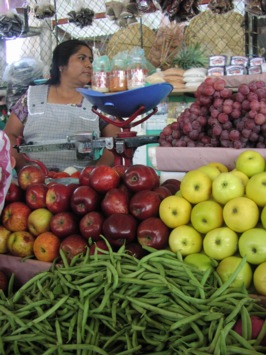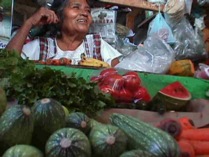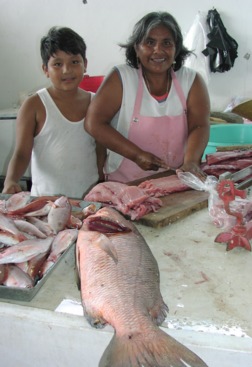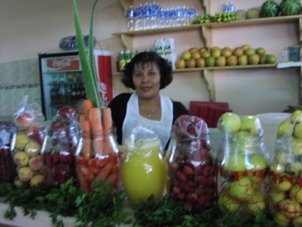

One of the great cuisines of the world, Mexican cooking must also rank as one of the oldest. By 2000B.C., the Meso America societies were agricultural, but 5,000 years earlier, the hunter-gathers began cultivating the crops which remain the staples of the Mexican diet today.
While Mexican cooking varies from one region of the country to another, no state compares with Oaxaca in the variety of cuisines found within its borders, just as Oaxaca boasts the greatest diversity of flora and fauna, of indigenous cultures, music and artistic expression.
Many of the dishes you will encounter will be familiar; others may cause consternation to those unaccustomed to eating insects or cacti, for example. Dried grasshoppers (chapulines) are a favorite Oaxacan snack and the huge flying ants known as chicatanes that swarm the area at beginning of the rainy season, are enthusiastically scooped up by the hundreds to be cooked in a spicy sauce, a dish that is considered a great delicacy.
The pricky pear cactus (genus opuntia) provides nopales, the tender pads that are used in scores of recipes, from soups to stews. In flavor and texture, they are similar to green beans. The same cactus provides the tuna and pitaya, fruits mostly used in drinks and desserts and chayote squash.
The main meal of the day is la comida. This is eaten between about 1:30 and 4 p.m., during the hottest part of the day when many businesses close down for siesta. Many restaurants offer a comida corrida, roughly equivalent to the French table d'hôte, a bargain-priced fixed menu of up to three courses, sometimes including beverage.
Dinner or cena is normally eaten late and is generally a lighter meal, a bowl of pozole, or a salad and seafood cocktail or some tacos and antojitos.
 The subtropical coastal plains and the temperate agricultural zones in the Valley of Oaxaca
guarantee a year-round supply of fresh fruits and vegetables. (Market days are Saturday and
Wednesday, when you will find the best selection of produce.)
The subtropical coastal plains and the temperate agricultural zones in the Valley of Oaxaca
guarantee a year-round supply of fresh fruits and vegetables. (Market days are Saturday and
Wednesday, when you will find the best selection of produce.)
Papayas, oranges, bananas (at least a half-dozen varieties), tangerines, pineapples, and limes are always available. But there are special seasons that are anxiously awaited. The summer months mark the onset of Mangomania. This juicy fruit has been described as tasting like a resiny peach, or an apricot crossed with a pineapple.
 Then there is the whole gamut of tropical exotica: guayabas, chirimoyas, mameys, zapotes, anonas,
ciruelas, tejocotes, tunas, to name just a few. Some are used solely in juices and deserts, others
are delicious eaten as is. Try, for example, chico zapote, a fruit that looks like an
oversized kiwi. Chilled and at just the right degree of ripeness, it tastes like a creamy custard.
Amazing!
Then there is the whole gamut of tropical exotica: guayabas, chirimoyas, mameys, zapotes, anonas,
ciruelas, tejocotes, tunas, to name just a few. Some are used solely in juices and deserts, others
are delicious eaten as is. Try, for example, chico zapote, a fruit that looks like an
oversized kiwi. Chilled and at just the right degree of ripeness, it tastes like a creamy custard.
Amazing!
 It's called Puerto Escondido, as in Port, as in surrounded by salty wet stuff. If you don't eat
seafood, you're missing out on a lot. The harvests of the sea are a primary local economic resource
and an important -- and delicious -- means of sustenance. Tuna, dorado, snapper, grouper, shrimp,
oysters are permanent features on local menus and fish markets. Just about every local restaurant
offers fish in one form or another: a simple caldo de pescado (fish soup); filete
(fish filet); or pescado entero (whole fish).
It's called Puerto Escondido, as in Port, as in surrounded by salty wet stuff. If you don't eat
seafood, you're missing out on a lot. The harvests of the sea are a primary local economic resource
and an important -- and delicious -- means of sustenance. Tuna, dorado, snapper, grouper, shrimp,
oysters are permanent features on local menus and fish markets. Just about every local restaurant
offers fish in one form or another: a simple caldo de pescado (fish soup); filete
(fish filet); or pescado entero (whole fish).
You can order your fish empanizado (breaded and fried); al mojo de ajo (garlic butter), a la veracruzana (Veracruz-style with tomatoes, onions garlic, and peppers ), a la diabla ("devil-style," in a fiery pepper sauce) or en salsa verde (green chili sauce), to name just a few variations.
The more upscale restaurants catering to visitors offer sumptuous dishes such as the Pacific spiny lobster and, a local specialty, pescado empapelado (parchment-wrapped fish -- although it is just as likely to be wrapped in banana leaf or foil) stuffed with shrimp and other seafood.
Mole (pronounced "moe-lay") is the most internationally known of all Mexican foods especially the "Poblano" with its 20 ingredients. But among Mexicans "Mole Negro Oaxaqueño" with up to 30 ingredients rivals and may even surpass it as a favorite. The truth is that every family has its own favorite recipe.
The word mole comes from "molli" of the language of the Aztecs, Nahuatl, and means sauce or stew. Although some moles have a small amount of chocolate mole is not a chocolate sauce as many North Americans think. Aside from their smooth consistency of one thing all moles have in common is chili peppers, some as many as five different varieties. The rest of the ingredients include red and green tomatoes, garlic, onion, sesame, squash seeds, almonds, pecans, anise, peanuts, bread crumbs, among many others, and vary depending on the type of mole. There are several different dishes that carry the word mole in their names aside from the black there is rojo (red), amarillo (yellow), verde (green), coloradito (little red) and guacamole among others.
Oaxaca is also renowned for its antojitos "little fancies". You will see these snacks almost everywhere. They are almost invariably made of masa (corn dough) stuffed or topped with cheese, beans, salsas, meat, potatoes, etc. Unlike the greasy antojitos of other parts of México, a majority of those made in Oaxaca are cooked on an ungreased griddle, a comal, not fried. The most traditionally Oaxaqueñan and one of the most popular of these delicious snacks is called a tlayuda this is a giant tortilla prepared like a "Mexican pizza", others are sopes, chalupas, picadas, molotes, tostadas and empanadas; be brave, experiment!
Tacos are also popular here. but most taquerías "taco shops" have a variety of tacos with fanciful names such as alambre "wire", sincronizadas "synchronized", gringas, mula terca "stubborn mule" among others. Most taquerías also serve pozole a hearty pork or sometimes chicken based soup with tender hominy corn and other vegetables. It's served fairly bland with a plate of seasonings that you add according to your taste: onions, oregano, lime, chili, chili powder, etc.
Quesillo or queso Oaxaca is a type of string cheese is another Oaxacan specialty it is delicious in quesadillas "cheese filled turnovers" or queso fundido "melted cheese" prepared alone or with mushrooms, chorizo "spicy Mexican sausage", or other combinations.
On many menus you will find dishes like enfrijolada, entomatadas, enmoladas and enchiladas, these are sauteed tortillas soaked in bean, tomato or mole sauce and dressed with white cheese, raw onions and parsley. You will also find dishes such as salsa de queso, salsa de huevo, or salsa de chicharron. These are cheese, egg or pork cracklings cooked in a tomato-based chili sauce.
Many of the sauces you'll see on menus are named for one of the many different kinds of chilies used, chipotle, poblana, pasilla or guajillo, for example.
The unique smoky flavor typical of many of the dishes comes from roasting the chilies and tomatoes over a flame before they're blended into the sauce.
Consequently, after Mexican and seafood restaurants, Italian restaurants are the most numerous. But within these pages you'll find excellent restaurants serving Spanish, French, German, and Asian cuisines and many fine restaurants serving the familiar fare referred to as Continental or International.
The aguas sold by the street vendors are made from fresh fruits and purified water and are a staple here. Among the favorites are jamaica, a kind of hibiscus, sandia, watermelon and coco, coconut milk. Some vendors offer tepache, slightly fermented cane juice.
And the, of course, there's the famous mescal, a highly potent spirit distilled from the agave. But that will have to wait for a future issue.
So enjoy these gustatory gifts. Browse through the pages of this magazine and sample the fare offered by our advertisers.
Thanks to them we are able to deliver this magazine to you without cost.
(And please let them know that you read about them in El Sol de la Costa.)
Be adventurous, try something new. You've little to lose, because prices are so low. A few dollars will buy a satisfying feast at most modest restaurants. You can even eat a gourmet meal for less than it will cost you to be seated in an equivalent restaurant in Europe and North America.
¡Buen Provecho!
